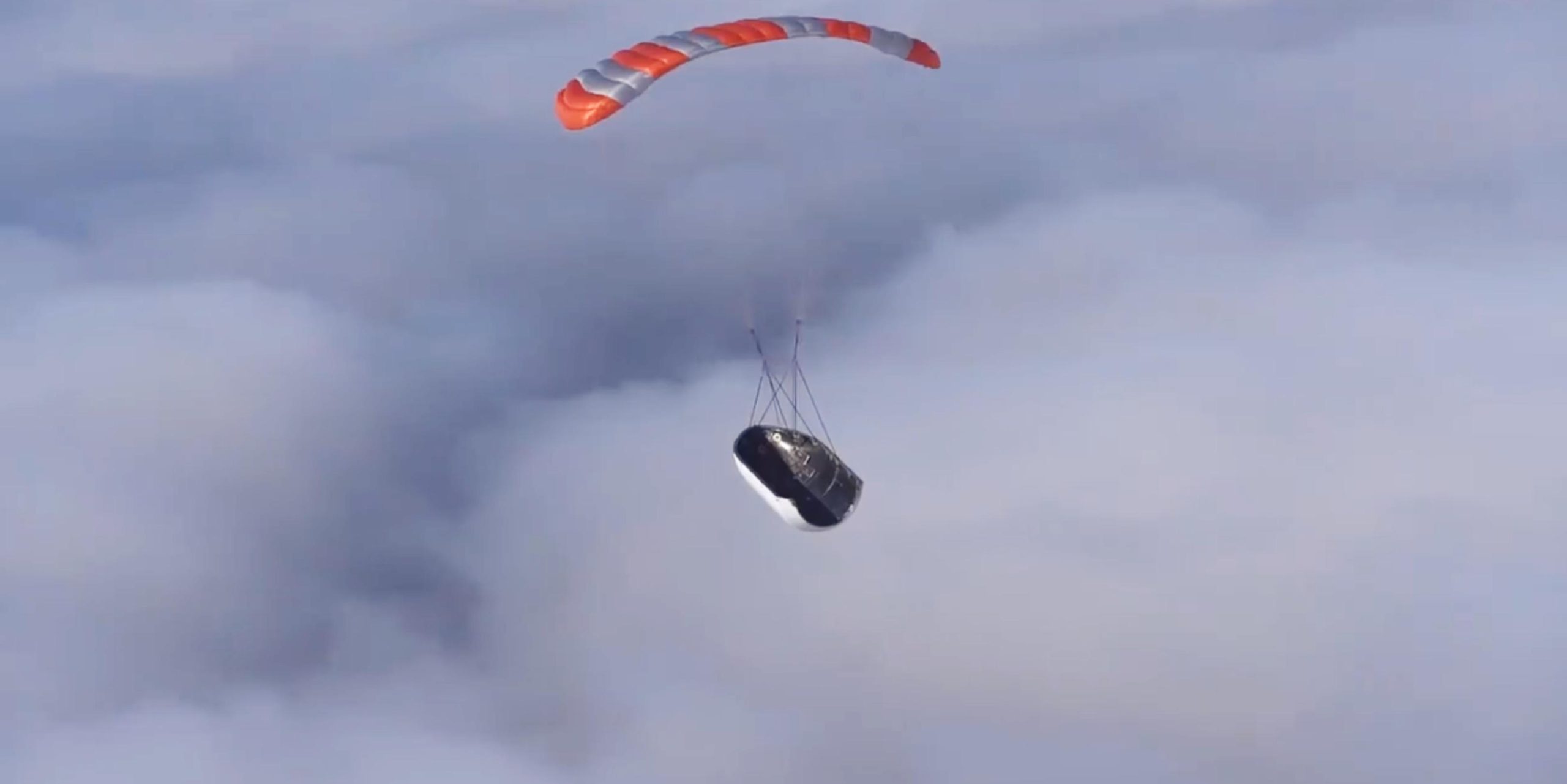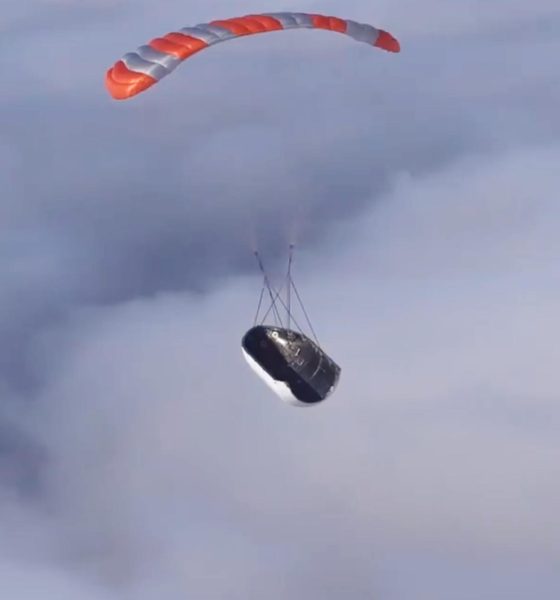

News
SpaceX ship Mr. Steven renamed ahead of Falcon Heavy fairing catch attempt
In a pleasant, last-minute surprise, SpaceX fairing recovery vessel Mr. Steven has departed Port Canaveral for its first Falcon fairing catch attempt in more than half a year. The speedy ship has already traveled more than 1250 km (800 mi) in ~48 hours and should soon be in position to attempt recovery of Falcon Heavy Flight 3’s payload fairing halves.
In another surprise, Mr. Steven has been renamed to GO Ms. Tree, a strong indicator that Guice Offshore (GO) – a company SpaceX is heavily involved with – has acquired the vessel from financially troubled owner/operator Sea-Tran Marine. With this likely acquisition, nearly all of SpaceX’s non-drone ship vessels are now leased from – and partially operated by – GO. The name change is undeniably bittersweet for those that have been following Mr. Steven’s fairing recovery journey from the beginning. However, it’s also more than a little fitting given that the vessel switched coasts and suffered an accident that forced SpaceX to replace the entirety of its arm-boom-net assembly. Much of Mr. Steven – now GO Ms. Tree – has been replaced in the last few months and with any luck, the vessel is better equipped than ever before to snag its first Falcon fairing(s) out of the air. Falcon Heavy is scheduled to lift off no earlier than (NET) 11:30 pm ET (03:30 UTC), June 24th.
♫ [Mr. Steven] would [sail nine] hundred miles ♫
Not one to dip his/her toes in first, Mr. Steven/GO Ms. Tree’s first fairing recovery attempt since crossing the Panama Canal will be a record-breaker. In yet another last-second surprise, Falcon Heavy Flight 3 – assigned to the US Air Force’s Space Test Program 2 (STP-2) mission – had its center core recovery profile radically modified just days ago, moving the booster’s drone ship landing from ~40 km offshore to more than 1240 km (770 mi) off the coast of Florida.
Given that the upper stage and its fairing-shrouded payload inherently separate after the center stage, after which the two fairing halves are ejected, those fairings will end up even further downrange than the center stage. In the case of Falcon Heavy’s STP-2 mission, the fairing halves could end up splashing down (or, hopefully, landing in a net) anywhere from 1400-1600 km (870-1000 mi) downrange from SpaceX’s Pad 39A Cape Canaveral launch facilities.

Records on records
With a fairing recovery attempt more than ~1400 km downrange and an attempted Falcon Heavy center core landing nearly 1250 km off the Florida coast, Falcon Heavy’s STP-2 mission is chock-full of records. As discussed previously on Teslarati, aside from the surprise recovery records-to-be, STP-2 will be a milestone launch attempt for several additional reasons.
“To successfully complete STP-2, the upper stage will be subjected to ‘four separate upper-stage engine burns, three separate deployment orbits, a final propulsive passivation maneuver, and a total mission duration of over six hours.‘ It will likely be SpaceX’s most technically-challenging launch ever.”
— Teslarati.com, 06/19/2019
“The US Air Force has decided that STP-2 presents an excellent opportunity to begin the process of certifying flight-proven SpaceX rockets for military launches. The STP-2-related work is more of a preliminary effort for the USAF to actually figure out how to certify flight-proven commercial rockets, but it will still be the first time a dedicated US military mission has flown on a flight-proven launch vehicle. Down the road, the processes set in place thanks – in part – to STP-2 and Falcon Heavy may also apply to aspirational rockets like Blue Origin’s New Glenn and ULA’s “SMART” proposal for Vulcan reuse.”
— Teslarati.com, 06/16/2019
In almost every conceivable way, STP-2 will absolutely be the most challenging launch SpaceX has ever attempted. Success would effectively confirm beyond any reasonable doubt that SpaceX is just as capable as – if not more capable than – its sole US competitor, Lockheed Martin and Boeing’s United Launch Alliance (ULA). On top of being able to compete for and perform all mission profiles required by the US military and NASA, SpaceX will also remain the only entity (private or public) in the world that is actively launching, landing, and refusing orbital-class rocket hardware.
Tune in to SpaceX’s hosted webcast around 11:15 pm ET (03:15 UTC), June 24th to watch Falcon Heavy’s third launch ever and (hopefully) catch a glimpse of multiple record-breaking recovery attempts and Falcon S2’s most challenging mission ever.
Want to remember the awesomeness of Falcon Heavy every single day? Consider a limited-edition set of high-quality prints, signed by both Teslarati photographers to commemorate the rocket’s inaugural Starman launch.

News
Tesla FSD (Supervised) v14.2.2 starts rolling out
The update focuses on smoother real-world performance, better obstacle awareness, and precise end-of-trip routing, among other improvements.

Tesla has started rolling out Full Self-Driving (Supervised) v14.2.2, bringing further refinements to its most advanced driver-assist system. The new FSD update focuses on smoother real-world performance, better obstacle awareness, and precise end-of-trip routing, among other improvements.
Key FSD v14.2.2 improvements
As noted by Not a Tesla App, FSD v14.2.2 upgrades the vision encoder neural network with higher resolution features, enhancing detection of emergency vehicles, road obstacles, and human gestures. New Arrival Options let users select preferred drop-off styles, such as Parking Lot, Street, Driveway, Parking Garage, or Curbside, with the navigation pin automatically adjusting to the user’s ideal spot for precision.
Other additions include pulling over for emergency vehicles, real-time vision-based detours for blocked roads, improved gate and debris handling, and extreme Speed Profiles for customized driving styles. Reliability gains cover fault recovery, residue alerts on the windshield, and automatic narrow-field camera washing for new 2026 Model Y units.
FSD v14.2.2 also boosts unprotected turns, lane changes, cut-ins, and school bus scenarios, among other things. Tesla also noted that users’ FSD statistics will be saved under Controls > Autopilot, which should help drivers easily view how much they are using FSD in their daily drives.
Key FSD v14.2.2 release notes
Full Self-Driving (Supervised) v14.2.2 includes:
- Upgraded the neural network vision encoder, leveraging higher resolution features to further improve scenarios like handling emergency vehicles, obstacles on the road, and human gestures.
- Added Arrival Options for you to select where FSD should park: in a Parking Lot, on the Street, in a Driveway, in a Parking Garage, or at the Curbside.
- Added handling to pull over or yield for emergency vehicles (e.g. police cars, fire trucks, ambulances).
- Added navigation and routing into the vision-based neural network for real-time handling of blocked roads and detours.
- Added additional Speed Profile to further customize driving style preference.
- Improved handling for static and dynamic gates.
- Improved offsetting for road debris (e.g. tires, tree branches, boxes).
- Improve handling of several scenarios, including unprotected turns, lane changes, vehicle cut-ins, and school buses.
- Improved FSD’s ability to manage system faults and recover smoothly from degraded operation for enhanced reliability.
- Added alerting for residue build-up on interior windshield that may impact front camera visibility. If affected, visit Service for cleaning!
- Added automatic narrow field washing to provide rapid and efficient front camera self-cleaning, and optimize aerodynamics wash at higher vehicle speed.
- Camera visibility can lead to increased attention monitoring sensitivity.
Upcoming Improvements:
- Overall smoothness and sentience.
- Parking spot selection and parking quality.
News
Tesla is not sparing any expense in ensuring the Cybercab is safe
Images shared by the longtime watcher showed 16 Cybercab prototypes parked near Giga Texas’ dedicated crash test facility.

The Tesla Cybercab could very well be the safest taxi on the road when it is released and deployed for public use. This was, at least, hinted at by the intensive safety tests that Tesla seems to be putting the autonomous two-seater through at its Giga Texas crash test facility.
Intensive crash tests
As per recent images from longtime Giga Texas watcher and drone operator Joe Tegtmeyer, Tesla seems to be very busy crash testing Cybercab units. Images shared by the longtime watcher showed 16 Cybercab prototypes parked near Giga Texas’ dedicated crash test facility just before the holidays.
Tegtmeyer’s aerial photos showed the prototypes clustered outside the factory’s testing building. Some uncovered Cybercabs showed notable damage and one even had its airbags engaged. With Cybercab production expected to start in about 130 days, it appears that Tesla is very busy ensuring that its autonomous two-seater ends up becoming the safest taxi on public roads.
Prioritizing safety
With no human driver controls, the Cybercab demands exceptional active and passive safety systems to protect occupants in any scenario. Considering Tesla’s reputation, it is then understandable that the company seems to be sparing no expense in ensuring that the Cybercab is as safe as possible.
Tesla’s focus on safety was recently highlighted when the Cybertruck achieved a Top Safety Pick+ rating from the Insurance Institute for Highway Safety (IIHS). This was a notable victory for the Cybertruck as critics have long claimed that the vehicle will be one of, if not the, most unsafe truck on the road due to its appearance. The vehicle’s Top Safety Pick+ rating, if any, simply proved that Tesla never neglects to make its cars as safe as possible, and that definitely includes the Cybercab.
Elon Musk
Tesla’s Elon Musk gives timeframe for FSD’s release in UAE
Provided that Musk’s timeframe proves accurate, FSD would be able to start saturating the Middle East, starting with the UAE, next year.

Tesla CEO Elon Musk stated on Monday that Full Self-Driving (Supervised) could launch in the United Arab Emirates (UAE) as soon as January 2026.
Provided that Musk’s timeframe proves accurate, FSD would be able to start saturating the Middle East, starting with the UAE, next year.
Musk’s estimate
In a post on X, UAE-based political analyst Ahmed Sharif Al Amiri asked Musk when FSD would arrive in the country, quoting an earlier post where the CEO encouraged users to try out FSD for themselves. Musk responded directly to the analyst’s inquiry.
“Hopefully, next month,” Musk wrote. The exchange attracted a lot of attention, with numerous X users sharing their excitement at the idea of FSD being brought to a new country. FSD (Supervised), after all, would likely allow hands-off highway driving, urban navigation, and parking under driver oversight in traffic-heavy cities such as Dubai and Abu Dhabi.
Musk’s comments about FSD’s arrival in the UAE were posted following his visit to the Middle Eastern country. Over the weekend, images were shared online of Musk meeting with UAE Defense Minister, Deputy Prime Minister, and Dubai Crown Prince HH Sheikh Hamdan bin Mohammed. Musk also posted a supportive message about the country, posting “UAE rocks!” on X.
FSD recognition
FSD has been getting quite a lot of support from foreign media outlets. FSD (Supervised) earned high marks from Germany’s largest car magazine, Auto Bild, during a test in Berlin’s challenging urban environment. The demonstration highlighted the system’s ability to handle dense traffic, construction sites, pedestrian crossings, and narrow streets with smooth, confident decision-making.
Journalist Robin Hornig was particularly struck by FSD’s superior perception and tireless attention, stating: “Tesla FSD Supervised sees more than I do. It doesn’t get distracted and never gets tired. I like to think I’m a good driver, but I can’t match this system’s all-around vision. It’s at its best when both work together: my experience and the Tesla’s constant attention.” Only one intervention was needed when the system misread a route, showcasing its maturity while relying on vision-only sensors and over-the-air learning.








